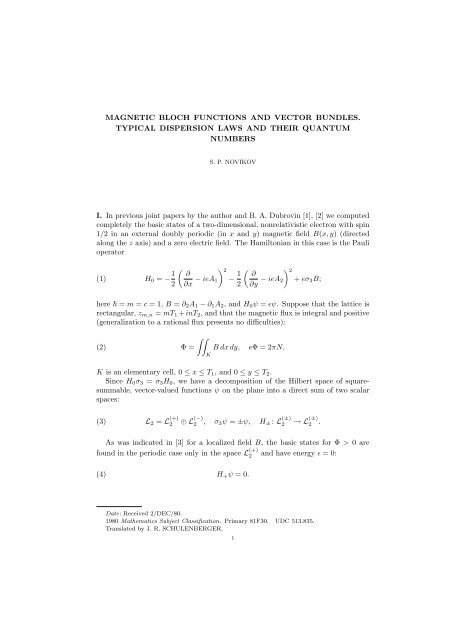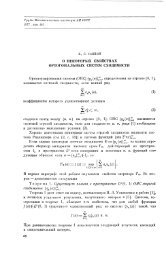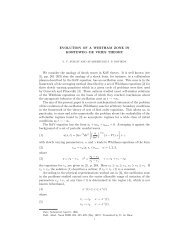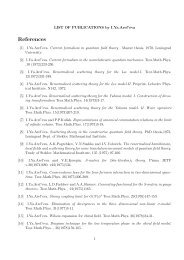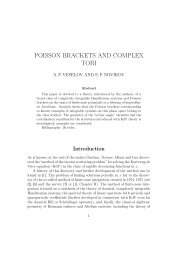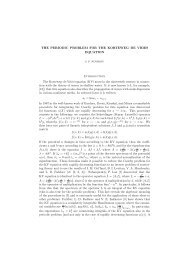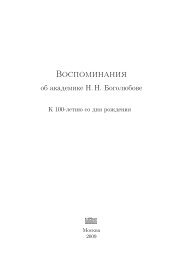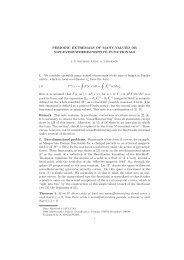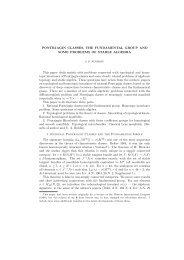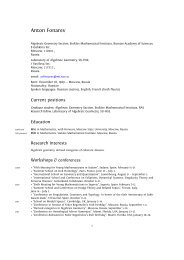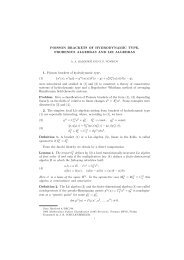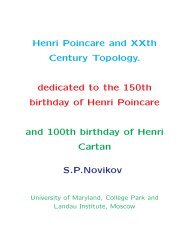MAGNETIC BLOCH FUNCTIONS AND VECTOR BUNDLES ...
MAGNETIC BLOCH FUNCTIONS AND VECTOR BUNDLES ...
MAGNETIC BLOCH FUNCTIONS AND VECTOR BUNDLES ...
Create successful ePaper yourself
Turn your PDF publications into a flip-book with our unique Google optimized e-Paper software.
<strong>MAGNETIC</strong> <strong>BLOCH</strong> <strong>FUNCTIONS</strong> <strong>AND</strong> <strong>VECTOR</strong> <strong>BUNDLES</strong>.<br />
TYPICAL DISPERSION LAWS <strong>AND</strong> THEIR QUANTUM<br />
NUMBERS<br />
S. P. NOVIKOV<br />
I. In previous joint papers by the author and B. A. Dubrovin [1], [2] we computed<br />
completely the basic states of a two-dimensional, nonrelativistic electron with spin<br />
1/2 in an external doubly periodic (in x and y) magnetic field B(x, y) (directed<br />
along the z axis) and a zero electric field. The Hamiltonian in this case is the Pauli<br />
operator<br />
(1) H 0 = − 1 2<br />
( 2 ∂<br />
1)<br />
∂x − ieA − 1 ( ) 2 ∂<br />
2 ∂y − ieA 2 + eσ 3 B;<br />
here = m = c = 1, B = ∂ 2 A 1 − ∂ 1 A 2 , and H 0 ψ = ɛψ. Suppose that the lattice is<br />
rectangular, z m,n = mT 1 + inT 2 , and that the magnetic flux is integral and positive<br />
(generalization to a rational flux presents no difficulties):<br />
∫∫<br />
(2) Φ = B dx dy,<br />
K<br />
eΦ = 2πN,<br />
K is an elementary cell, 0 ≤ x ≤ T 1 , and 0 ≤ y ≤ T 2 .<br />
Since H 0 σ 3 = σ 3 H 0 , we have a decomposition of the Hilbert space of squaresummable,<br />
vector-valued functions ψ on the plane into a direct sum of two scalar<br />
spaces:<br />
(3) L 2 = L (+)<br />
2 ⊕ L (−)<br />
2 , σ 3 ψ = ±ψ, H ± : L (±)<br />
2 → L (±)<br />
2 .<br />
As was indicated in [3] for a localized field B, the basic states for Φ > 0 are<br />
found in the periodic case only in the space L (+)<br />
2 and have energy ɛ = 0:<br />
(4) H + ψ = 0.<br />
Date: Received 2/DEC/80.<br />
1980 Mathematics Subject Classification. Primary 81F30. UDC 513.835.<br />
Translated by J. R. SCHULENBERGER.<br />
1
2 S. P. NOVIKOV<br />
The formulas for the basic states are as follows (see [1] and [2]; for the properties<br />
of σ see [4]):<br />
N∏<br />
ψ = ψ A = λ exp(−eφ) σ(z − a j ) exp(az),<br />
(5)<br />
j=1<br />
φ = 1 ∫∫<br />
ln |σ(z − z ′ )| B(x ′ , y ′ ) dx ′ dy ′ , z = x + iy,<br />
2π K<br />
∏<br />
{<br />
σ(z) = z (1 − z/z m,n ) exp z/z m,n − 1 }<br />
2 z2 /zm,n<br />
2 ,<br />
m 2 +n 2 ≠0<br />
⎧ ⎡<br />
⎤⎫<br />
⎨<br />
η 1<br />
N∑<br />
Re a = Re ⎣2 a<br />
⎩<br />
j − e ∫∫<br />
⎬<br />
zB dx dy⎦<br />
T 1 π<br />
j=1<br />
k ⎭ ,<br />
⎧ ⎡<br />
⎤⎫<br />
⎨<br />
η 2<br />
N∑<br />
Im a = Im ⎣2 a j − e ∫∫<br />
⎬<br />
zB dx dy⎦<br />
⎩T 2 π<br />
⎭ ,<br />
j=1<br />
A = (a 1 , a 2 , . . . , a N , λ),<br />
where λ is any number, η 1 = ξ(T 1/2 ), iη 2 = ξ(iT 2/2 ) and ξ(z) = σ ′ /σ.<br />
The states (5) are “magnetic Bloch” states, i.e., they are the eigenstates for the<br />
operators of “magnetic translations” T1<br />
∗ and T2 ∗ , which commute with the Hamiltonian<br />
and have unimodular eigenvalues (this is a projective representation of the<br />
discrete group of translations):<br />
(6)<br />
T ∗ 1 ψ A = exp(ip 1 T 1 )ψ A = ψ A (x + T 1 , y) exp{−ieη 1 Φy/π},<br />
T ∗ 2 ψ A = exp(ip 2 T 2 )ψ A = ψ A (x, y + T 2 ) exp{−ieηΦy/π},<br />
p 1 + ip 2 = 2πi ∑<br />
aj + const, T1 ∗ T2 ∗ = T2 ∗ T1 ∗ exp(−eΦ).<br />
T 1 T 2<br />
The states (5) form a complete basis in L 2 of solutions of the equation H 0 ψ = ɛψ<br />
for ɛ = 0 and generate a subspace L 0 2 in L 2 which is distinguished by the direct<br />
sum L 2 = L 0 2 ⊕ L 1 2 in a manner similar to the case of a discrete level; according to<br />
[2], it is possible to choose a discrete basis of localized “Wannier states” in L 0 2 in<br />
place of the continuous magnetic Bloch basis (5).<br />
We note a useful supplement to a result of [1] and [2].<br />
Theorem 1. For any integral or rational flux eΦ = 2πNM −1 the basic states (5)<br />
are separated from the remaining energy levels (eigenvalues of H 0 ψ = ɛψ) by a<br />
finite gap ∆{B}.<br />
Conjecture. The gap ∆{B} varies continuously with the magnetic field B(x, y)<br />
in the class of doubly periodic fields with arbitrary periods (which may vary and<br />
therefore pass through irrational fluxes).<br />
The proof of Theorem 1 for integral fluxes follows easily from the following<br />
consideration: fixing the quasimomentum (p 1 , p 2 ), we obtain an elliptic, selfadjoint<br />
operator H 0 (p 1 , p 2 ) in a bundle over a compact manifold—the torus T 2 , where the<br />
connectivity is defined by the field B. Therefore, the spectrum ɛ j (p 1 , p 2 ) is discrete,<br />
of finite multiplicity, and depends continuously on the parameters p 1 , p 2 . Following<br />
[1], [2], we know that a) ɛ 0 = ɛ min (p 1 , p 2 ) = 0 for all (p 1 , p 2 ); and b) the dimension<br />
of this eigensubspace is equal to N, and it varies continuously together with the<br />
k
<strong>MAGNETIC</strong> <strong>BLOCH</strong> <strong>FUNCTIONS</strong> <strong>AND</strong> <strong>VECTOR</strong> <strong>BUNDLES</strong> 3<br />
quasimomenta (p 1 , p 2 ) (without bifurcations) because of formulas (5). Further, the<br />
next eigenvalue ɛ 1 (p 1 , p 2 ) is positive and depends continuously on (p 1 , p 2 ). The<br />
equality ɛ 1 (p 0 1, p 0 2) = 0 is impossible because of the absence of bifurcation of the<br />
eigensubspace with level ɛ 0 = 0. Therefore, ∆ = min (p1,p 2) ɛ 1 (p 1 , p 2 ) > 0.<br />
For rational fluxes the proof also reduces to the proof for integral fluxes.<br />
Remark. The two-dimensional Pauli operator (1) with a zero electric potential on<br />
the subspace L (+)<br />
2 reduces to the scalar Schrödinger operator (with spin 0)<br />
(7) H = H + = − 1 ( 2 ∂<br />
1)<br />
2 ∂x − ieA − 1 ( ) 2 ∂<br />
2 ∂y − ieA 2 + eV (x, y)<br />
with a nonzero but special electric potential V :<br />
(8) ∂ 1 A 2 − ∂ 2 A 1 = V (x, y)<br />
(in the system of units c = = m = 1). Under the condition (8) we denote the<br />
operator H by H 0 . Later we shall also consider the general Schrödinger operator<br />
(7) where the condition (8) is not satisfied.<br />
For the Schrödinger operator (7) we have two integrable cases: a) V ≡ 0 and<br />
the field B = const is homogeneous; b) condition (7) is satisfied, but the field B is<br />
arbitrary (only the lowest level ɛ = 0 can be integrated). In both cases we denote<br />
the operator H by H 0 .<br />
II. An important property of the basic states (5) (which also occurs for the Landau<br />
levels in the homogeneous field B = const) is that the magnetic Bloch functions<br />
(5) for, integral number of quanta of the flux N ≠ 0 form a topologically nontrivial<br />
vector bundle over the torus T 2 . Under variation of any a j over a lattice period<br />
a j → a j + T 1 or a j → a j + iT 2 the σ-function is multiplied by an exponential. This<br />
variation is compensated by the variation of the quantity a(a 1 , . . . , a N ) in (5):<br />
(9) a(. . . , a j + T 1 , . . . ) = a + 2η 1 , a(. . . , a j + iT 2 , . . . ) = a + 2iη 2 .<br />
We thus obtain a “gluing law” for the complete space E of the vector bundle ξ<br />
with is defined by (9); from this it follows that<br />
(10)<br />
(λ, a 1 , a 2 , . . . , a N ) ≃ (λ, a i1 , a i2 , . . . , a iN ),<br />
(λ, a 1 , a 2 , . . . , a N ) ≃ (λ ′ , a 1 , a 2 , . . . , a j + T 1 , . . . , a N ),<br />
(λ, a 1 , a 2 , . . . , a N ) ≃ (λ ′′ , a 1 , a 2 , . . . , a j + iT 2 , . . . , a N ),<br />
λ ′ = λ exp{2η 1 a j + η 1 T 1 + iπ},<br />
λ ′′ = λ exp{2iη 2 a j − η 2 T 2 + iπ}.<br />
As indicated in [1] and [2], for a fixed quasimomentum we have a vector space<br />
C N (p 1 , p 2 ) of functions ψ A : they are all obtained from ψ A0 by multiplication by<br />
a meromorphic, doubly periodic elliptic function with the same lattice, i.e. ψ A =<br />
ψ A0 χ. The function χ(z) must have poles at some of the points a j , so that the<br />
product again has no poles.<br />
Lemma 1. The mapping of quasimomentum<br />
p = p 1 + ip 2 : E → 2πi ∑<br />
a j + const<br />
T 1 T 2<br />
transforms the manifold E of all magnetic Bloch functions (5) of the basic state<br />
(ɛ = 0) into a vector bundle ξ with fiber C N over the torus T 2 obtained from the<br />
j
4 S. P. NOVIKOV<br />
reciprocal lattice (T −1<br />
1 , T −1<br />
2 ). This bundle is topologically nontrivial for all N > 0<br />
and has nonzero first Chern class c 1 (ξ) = 1 ≠ 0.<br />
This lemma is derived from (10) in a topologically standard way, and we shall<br />
not prove it.<br />
Remark. This lemma is also true for the magnetic Bloch functions of any Landau<br />
level in a homogeneous field B = const. 1<br />
III. Of course, the very fact of the occurrence of a situation of rank N (i.e., a bundle<br />
ξ with an N-dimensional fiber) for the magnetic Bloch functions over the torus T 2<br />
implies very strong degeneracy for N ≥ 2. This degeneracy should vanish under<br />
small perturbations. We shall consider small perturbations of the Hamiltonian by<br />
an electric, doubly periodic potential W (x, y) with the same periods<br />
(11) H = H 0 + eW (x, y),<br />
where the operator H 0 is any of those studied in §§I and II. For N = 1 a small<br />
perturbation (and therefore also a perturbation which is not small) leads only to the<br />
formation of a “dispersion law” ɛ(p 1 , p 2 ) and spreading of any Landau level (or basic<br />
state for the operator (7), (8)) in a single magnetic zone due to the connectedness of<br />
the torus T 2 . The topology of the family of Bloch functions itself—the “dispersion<br />
law”—does not change under small deformation of the operator for N = 1 and<br />
remains the same as in §II for the operators H 0 . Thus, consideration of the singlequantum<br />
case N = 1 may lead to the illusion that the topology of all dispersion<br />
laws, although it is not trivial, is nevertheless completely determined by the flux<br />
of the external magnetic field B through an elementary cell—by the single integer<br />
N (this is actually the case for any small perturbations of the field B = const for<br />
N = 1).<br />
We consider the Hermitian form Ŵ (ψ A) on the fibers of the bundle ξ which is<br />
defined by a perturbation W (x, y) with the same periods (p 1 and p 2 are fixed):<br />
∫∫<br />
(12) Ŵ (ψ A ) = ψ A W ¯ψ A dx dy.<br />
Here there arise the real eigenvalues<br />
of the form Ŵ on the fibers CN (p 1 , p 2 ).<br />
K<br />
ɛ 1 (p 1 , p 2 ) ≥ ɛ 2 (p 1 , p 2 ) ≥ · · · ≥ ɛ N (p 1 , p 2 )<br />
Lemma 2. a) In the class of doubly periodic, real functions W (x, y) the condition<br />
of coalescence ɛ i = ɛ j for fixed (p 1 , p 2 ) is given by three independent conditions on<br />
the Fourier coefficients (this is also true in three-dimensional space). In particular,<br />
for functions in “general position” W (x, y) the coalescence e i (p 0 1, p 0 2) = ɛ j (p 0 1, p 0 2)<br />
for at least one quasimomentum p 0 1, p 0 2 of the given dispersion law has codimension<br />
1 in the function space (i.e., it is realized only at isolated points with respect to the<br />
parameter τ for “typical” one-parameter families of potentials W τ (x, y)).<br />
1 For a homogeneous field,<br />
eφ = eΦ » η1<br />
x 2 − η –<br />
2<br />
y 2 − η 1 x + η 2 y .<br />
2π T 1 T 2<br />
The operator A n takes the functions (5) into the Bloch functions of the nth Landau level, where<br />
»<br />
¯z + z<br />
A = − ∂<br />
∂x + i ∂<br />
∂y + eB 2<br />
„ T1 η 2<br />
π − 1 2<br />
«–<br />
− eΦ<br />
4π (η 1 + iη 2 ).
<strong>MAGNETIC</strong> <strong>BLOCH</strong> <strong>FUNCTIONS</strong> <strong>AND</strong> <strong>VECTOR</strong> <strong>BUNDLES</strong> 5<br />
b) In the three-dimensional space of the parameters (p 1 , p 2 , τ) there may be stable<br />
singular points (p 0 1, p 0 2, τ 0 ) such that ɛ i = ɛ j (for only one pair i, j) and the<br />
restrictions ξi δ and ξj δ of the one-dimensional bundles ξ i and ξ j to a small sphere<br />
Sδ 2 of radius δ surrounding the singular point are nontrivial (although their sum is<br />
trivial), ξ1 δ ⊕ ξ2 δ ∼ 0 on Sδ 2,<br />
(13) q = c 1 (ξ δ i ) = −c 1 (ξ δ j ).<br />
On passing through the value of the parameter τ = τ 0 the dispersion laws “collide”<br />
and are changed by the quantum number q = ±1:<br />
(14)<br />
c 1 = (ξ j ) τ0−δ = c 1 (ξ j ) τ0+δ + q,<br />
c 1 = (ξ i ) τ0−δ = c 1 (ξ i ) τ0+δ − q.<br />
c) For the Schrödinger operator in three-dimensional space the quasimomentum<br />
p 3 = τ plays the role of the parameter τ; therefore, the condition of coalescence for<br />
one quasimomentum (p 0 1, p 0 2, p 0 3) is stable, and the situation of part b) occurs.<br />
The following result is established using Lemma 2.<br />
Theorem 2. a) In the case of a small perturbing potential W (x, y) in “general<br />
position” the eigenvalues of the form Ŵ (ɛ 1(p , p 2 ) > ɛ 2 (p 1 , p 2 ) > · · · > ɛ N (p 1 , p 2 ))<br />
are distinct for any (p 1 , p 2 ) and provide a decomposition of the family (bundle) of<br />
magnetic Bloch functions ξ of the unperturbed operator H 0 into a direct sum of<br />
one-dimensional (fiber C 1 ) complex bundles<br />
(15) ξ = ξ 1 ⊕ ξ 2 ⊕ · · · ⊕ ξ N<br />
with the single condition on the first Chern class<br />
(16) c 1 (ξ) = 1 =<br />
N∑<br />
c 1 (ξ j ).<br />
b) The “monodromy group” generated by permutations of the eigenvalues ɛ j under<br />
basic circuits of the torus T 2 is, in general position, always trivial. Therefore,<br />
precisely N “decay” dispersion laws ɛ j (p 1 , p 2 ) are formed, with topological quantum<br />
numbers c 1 (ξ j ) = m j which can be any integers (positive or negative) with<br />
the single relation (16). These dispersion laws have rank 1 (i.e., the fibers are<br />
one-dimensional) and are therefore stable under further deformation (which is not<br />
small).<br />
c) In the three-dimensional case the potential W (x, y, z) occasions the decay of the<br />
family of magnetic Bloch functions (the bundle ξ) into a sum of bundles ξ 1 , . . . , ξ k<br />
(which are not necessarily one-dimensional), where each of the ξ j has fiber of dimension<br />
k j and decomposes into a sum of one-dimensional bundles after removal of the<br />
singular points from the torus T 3 according to the dispersion laws (ɛ j,1 , . . . , ɛ j,kj ):<br />
k j<br />
j=1<br />
∑<br />
(17) ɛ j = ξ j,s on T 2 \ (P j1 ∪ · · · ∪ P jm ),<br />
s=1<br />
where the branches ɛ js = ɛ jt with topological invariants q jα coalesce at the points<br />
P jα .<br />
Thus, by performing further large perturbations, we arrive at the following
6 S. P. NOVIKOV<br />
Conclusion. For a “general” two-dimensional Schrödinger operator (7) in a stationary<br />
magnetic field which is periodic in (x, y) with an integral flux N ≥ 2 and<br />
an electric field with a periodic potential there are a countable number of dispersion<br />
laws ɛ j (p 1 , p 2 ) for the magnetic Bloch functions. These dispersion laws (i.e.,<br />
Bloch functions) form one-dimensional (fiber C 1 ) bundles over the torus T 2 of the<br />
reciprocal lattice and have “quantum numbers” c 1 (ξ j ) = m j in no way connected<br />
with one another or with the flux N of the external magnetic field in the energy<br />
range where the perturbations of different Landau levels are “mixed” and cannot<br />
be separated from one another. 2 In a homogeneous magnetic field for sufficiently<br />
high energy levels a doubly periodic electric potential W (x, y) produces only a small<br />
perturbation of the levels of the homogeneous field. Therefore, the perturbed dispersion<br />
laws which arise from them do not overlap; condition (16) is satisfied for<br />
the dispersion laws arising from each Landau level individually. For the general<br />
three-dimensional Schrödinger operator the “typical” dispersion laws do not form<br />
only one-dimensional bundles over the torus T 3 , and the pairs of branches ɛ j and<br />
ɛ k coalesce for singular values of the quasimomentum.<br />
Remark 1. Comparison with some results of the author and Kričever (see [5])<br />
on integrable cases of rank greater than 1 shows that the conclusion regarding<br />
the occurrence of dispersion laws with completely random quantum numbers is<br />
probably also valid for N = 0 in periodic problems of dimension ≥ 2. This is<br />
probably also true for N = 1 if the perturbing potential is not small. However,<br />
here there is not an “integrable case” of even one dispersion law or of rank > 1 that<br />
might provide a proof from consideration of small perturbations.<br />
References<br />
[1] B. A. Dubrovin and S. P. Novikov, Dokl. Akad. Nauk SSSR 253 (1980), 1293; English transl.<br />
in Soviet Math. Dokl. 22 (1980).<br />
[2] , Ž. Èksper. Teoret. Fiz. 79 (1980), 1006; English transl. in Soviet Phys. JETP 52<br />
(1980).<br />
[3] Y. Aharonov and A. Casher, Phys. Rev. A (3) 19 (1979), 2461.<br />
[4] A. Erdélyi et al., Higher transcendental functions. Vol. 2, McGraw-Hill, 1953.<br />
[5] I. M. Kričever and S. P. Novikov, Uspehi Mat. Nauk 35 (1980), no. 6 (216), 47; English transl.<br />
in Russian Math. Surveys 35 (1980).<br />
Landau Institute of Theoretical Physics, Academy of Sciences of the USSR<br />
2 The corresponding Bloch function ψj (x, x 0 , p), where ψ j = 1 for x = x 0 , has an algebraic<br />
number of zeros, equal to N for fixed p{x jk (p)} and equal to m j for fixed x{p jl (x)}. The poles<br />
are located at points p jl (x 0 ).


